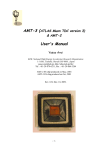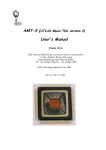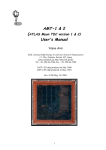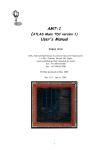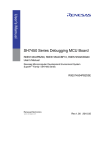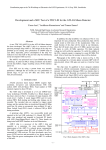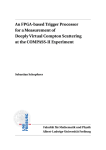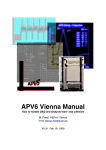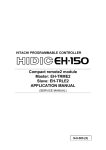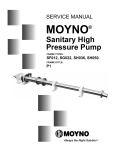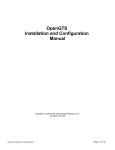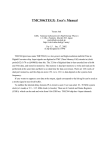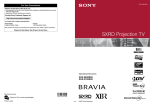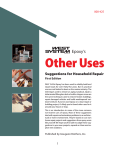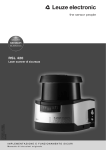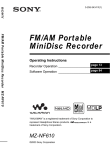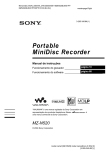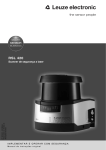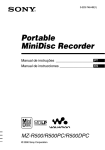Download AMT PRR Document (v1.1)
Transcript
Production Readiness Review ATLAS MDT TDC Chip (AMT) Review Date : June. 20, 2002 V1.0c June. 27, 2002 V1.1 Feb. 14, 2004 Yasuo Arai KEK, National High Energy Accelerator Research Organization Institute of Particle and Nuclear Studies [email protected], http://atlas.kek.jp/tdc/ 1 Contents 1. INTRODUCTION 3 2. REQUIREMENTS AND SPECIFICATIONS 4 2.1 2.2 2.3 2.4 3. MDT Front-end S y s t e m Requirements to the AMT Radiation tolerance requirements Architecture Study with Simulations 4 5 9 10 CIRCUIT DESCRIPTION & PERFORMANCE 15 3.1 3.2 3.3 3.4 3.5 3.6 3.7 3.8 3.9 3.10 3.11 3.12 3.13 3.14 4. DESIGN VERIFICATION & TEST 4.1 4.2 4.3 4.4 4.5 5. Design Flow & Design F i l e s Function Tests Time Resolution and Non-Linearity P o w er Consumption Summary of Tests and Known Problems 36 39 40 41 41 46 Gamma-ray Irradiation (TID) Neutron Irradiati o n Proton Irradiation (SEE) 46 46 48 QUALITY CONTROL AND PRODUCTION SCHEDULE 6.1 6.2 16 21 22 24 25 26 27 29 29 30 31 32 33 34 36 RADIATION TEST 5.1 5.2 5.3 6. Fine Time Measurement Coarse Counter Channel Buffer. Vernier Encoder L1 Buffer. Trigger Interface & Trigger FIFO Trigger Matching. Encoded trigger and resets signal Serial Readout Error monitoring. CSR Registers JTAG Port. ASD control through JTAG LVDS Receiver/Driver Quality Control Procurement and Production Schedule 48 48 48 7. SUMMARY 49 8. REFERENCES 50 2 1 . Introduction A TDC with sub-nano second resolution is required to obtain the necessary spatial resolution of the Monitored Drift Tubes (MDT). The high rates expected in the ATLAS detector requires that the TDC is capable of continuously accepting new hits while selectively extracting hits related to a trigger after the first level trigger latency. To do this several levels of data buffering is required to keep up with the trigger rates and hit rates expected in the experiment. In addition, high density and low-cost, low power consumption are required in the TDC. The TDC was named as AMT (ATLAS Muon TDC), and brief summary of the development history is shown in Table. 1. Table. 1. Brief summary of the history of TDC LSI development Year Activities 1990 First TDC LSI was developed (TMC1004, CMOS 0.8 µm) at KEK. 1994 TDC for the SSC exp. was developed (TMC304, CMOS 0.5 µm) at KEK 1996 Collaboration with CERN microelectronics group on the architecture study for the ATLAS TDC, and requirements document were written [1]. 1998 A quick test chip (AMT-0, CMOS 0.7 µm) was developed and produced at CERN. 1999 A test element chip (AMT-TEG, CMOS 0.3 µm) was developed at KEK. PLL and radiation torelance of the process were tested. 2000 A first prototype chip (AMT-1, CMOS 0.3 µm) was developed。 2001 Muon front end electronics Preliminary Design Review. Mezzanine boards with ASD-Lite and AMT-1 are developed and used in H8 beam test. Second prototype chip (AMT-2, CMOS 0.3 µm) was developed. 2002 Mezzanine board with ASD-8 and AMT-2 are developed and tested at Univ. of Michigan. Production Readiness Review. In 1996, architecture study was done in collaboration with CERN microelectronics group, and intensive Verilog simulations were done. Basic requirements on the AMT chip were documented in ATLAS note (MUON-NO-179 [1]) and presented at LEB97 workshop[2]. In 1998, AMT-0 [3] was designed in a 0.7 µm full custom CMOS process based on the 32 channel TDC designed at CERN for the quick test of front-end electronics and MDT chambers. On the other hand, it was decided to use a 0.3 µm CMOS Gate-Array process (Toshiba Co.) for a final production. To develop and test many critical elements in the 0.3 µm process, a TEG (Test Element Group) chip (AMT-TEG) was designed, fabricated and tested successfully at KEK [4, 5]. Then AMT-1 chip was developed. AMT-1 chip mainly consists of analog part of the AMT-TEG and logical part of the AMT-0. In February, 2001, Preliminary Design Review of the MDT front-end electronics was held and the AMT design was approved for final design with a few recommendations [6]. Mezzanine boards which implement AMT-1 and ASD-Lite chips are produced for 10k channel (~400 boards) test of MDT detector in 2001. They are used in the H8 beam test in September 2001. Although there were several troubles with electrical noise, DAQ hang up etc., more than 13 M events were acquired[7]. In parallel with the AMT-1 test, next version of the AMT chip (AMT-2) was designed and developed. It implements new low-power LVDS receivers to reduce power consumption. In addition, minor bugs were 3 fixed, testability is increased, and a JTAG control circuit for the ASD. Furthermore, clock timing within the chip was carefully adjusted. Recently a new mezzanine board which implements AMT-2 and ASD-8 chips are produced and being tested at Univ. of Michigan and many other places. During these development, preliminary radiation test had been done to the AMT-TEG, AMT-1, and we got a feeling that the gate-array process has adequate radiation tolerance. Then we have done gamma and proton irradiation test to the AMT-2 chip following ATLAS standard test method. 2 . Requirements and Specifications 2.1 MDT Front-end S y s t e m Block diagram of the MDT front-end electronics is shown in Fig. 1. Three ASD (Amp-Shaper-Discri) chips [8] and one AMT chip are mounted on a small multi-layer printed circuit board (mezzanine board, Fig. 2), which plugs into a MDT end plug PCB (signal hedgehog board). Two modes of operation will be provided in MDT measurement. In one mode the ASD output gives the time over threshold information, i.e. signal leading and trailing edge timing. The other mode measures leading edge time and charge (pulse width). The Wilkinson ADC serves as a time slew correction and also provides diagnostics for monitoring chamber gas gain. It operates by creating a gate of ~20ns width at the leading edge of the signal, integrating charge onto a holding capacitor during the gate, and then running down the hold capacitor at constant current (the maximum rundown time is of order 200ns). The discriminator also generates artificial dead time of ~800 ns to avoid multiple hits. Fig. 1 MDT front-end electronics. AMT chip receives timing signal from three ASD chips and sends data to a CSM. 4 Fig. 2. Mezzanine-Lite Board Layout. The TDC chip will be mounted with 3 ASD chips. 2.2 Requirements to the AMT We summarize the requirements to the AMT in this section. Although some parameters were changed in past 6 years, most of the requirements discussed in reference [1] are still valid. Number of channels per chip There are about 370,000 MDT tubes in total. Since the number of tube layers is 3 and 4, and the ASD chip will have 8 channels per chip, a 24 channel TDC matches well this configuration. In total 16,000 chips and some spare chips are required for the MDT. TDC Clock A TDC clock with the same frequency as the bunch crossing rate must be used. In this way the coarse time count can be correlated directly with the bunch count. In some internal parts of the TDC, such as the PLL or the serial interface, a 2 times higher clock frequency (80 MHz) is used to improve performance. A high speed clock in this case is phase locked to the beam clock. Time Resolution The resolution of one single MDT has to be better than 80 µm. During the development of the AMT chip, the baseline gas of the MDT was changed to Ar/CO2 93/7. This gas causes the non-linearity of the rtrelation and a longer drift time (tmax ~ 800 ns). Although the requirements to the time resolution was a little bit relieved, a timing resolution of better than 1 ns is sustained and ~300 ps resolution is foreseen in the AMT. Detection of Masked Hits and Shared Hits The signal from a round drift tube has a long tail. A second track might therefore be masked by the signal tail of a preceding track. The existence of a preceding hit can be detected by checking the data before the trigger matching region. This masked hit information can be sent out with one word per event using a flag bit for each channel. 5 Since the drift time of the MDT tubes is longer than the minimum interval between two triggers, some hits may be shared by several triggers. This is illustrated in Fig. 3 where some hits are shared for event N and N+1. Randomly accessed memory is therefore required instead of a FIFO for the first level buffer to handle shared data. Fig. 3. Mask & Matching window and a shared hit. Time Measurement and Pipeline Processing The maximum hit rate in a wire is estimated to be 400 kHz while most of wire has less than 100 kHz hit rate. Inefficiency due to the buffer overflow of the AMT must be negligible compared with detector inefficiency. The timing of both leading and trailing edge of the hit signal can be stored as a pair to enable a pulse width measurement to be performed. Optionally the leading edge only or the trailing edge only (or both independently) time measurement can be performed in case the pulse width measurement is not required. The signal path from the trigger and hit inputs to the readout contains several buffers so multiple events can be processed at the same time as shown in Fig. 4. One trigger in the process of being received, One event in the process of being trigger matched and a third event in the process of being read out. Fig. 4. Processing of several events in parallel. 6 Bunch Counter and Coarse Counter There are 3,564 clock periods per LHC beam revolution. Bunch crossings are identified with a 12 bit Bunch Crossing Identifier (BCID) [9]. To correctly identify hits within the bunch structure a 12 bit coarse time counter is required in the TDC. Trigger Interface When a trigger signal is given to the first level buffers, measurements related to that event must be extracted from the buffer and sent to the data acquisition system. Main trigger conditions given from ATLAS group are following; • maximum level 1 trigger rate is 75 kHz (100 kHz in future upgrade) • level 1 trigger latency is around 2.5 µs • minimum interval between two triggers is 125 ns Each event accepted by the first level trigger is identified by a 24 bit event ID at the system level. At the TDC a reduced event ID of 12 bits is used. Input and Output Signal Level It is of vital importance that noise from digital signals on the front-end board is kept to an absolute minimum so the small analog signal from the tubes are not corrupted. LVDS (Low Voltage Differential Signaling, IEEE 1596.3) signals are used for all connections to/from the TDC which are actively running while taking data. Data Packet and Output Band width Data packets of 32 bit are used in the serial data stream. The first four bits of the packet are allocated to a type identifier which specifies the type of data. The following four bits are allocated for a TDC chip identifier. This ID is used just for confirmation of the connection. Since maximum number of TDC per chamber is 18, actual TDC ID is added to data at the CSM. Event data from different events can be separated by the optional use of a header and a trailer. The header contains the event ID and bunch ID of the event being readout. The trailer contains the event ID and a word count. All required information from a hit: type identifier, TDC ID, channel ID, leading edge time plus pulse width are contained in one 32 bit word. The conditional mask flags for the 24 TDC channels are also contained in a single 32 bit word. In case a TDC have detected an internal error condition (e.g. buffer overflow) it sends a special error status packet for all events which may have been affected by the error. Hit data selected by a trigger is transferred from the TDC to the CSM (Chamber Service Module) located outside the detector. The distance from the TDCs to the CSM is of the order of 10 meters. The connection from the TDCs to the CSM is performed on serial links of 40 Mbits/s (optionally 80 Mbits/s is selectable for future upgrade). At a 400 kHz hit rate per TDC channel and a trigger matching window of 800 ns, an average of 6 hits per TDC is expected at highest rate locations. For each hit, 36 bits (32 bits data + start bit + 2 stop bit + parity) must be transferred from a TDC to the CSM. With a trigger rate of 100 kHz this requires an average serial bandwidth of 32 Mbits/s per TDC including the header, trailer and a mask word. 7 Serial Link Protocol A coding scheme of the serial data is the two wire signaling scheme. Two protocols and two clocking schemes are prepared. One protocol is the DS protocol ( IEEE P1355 ) which keeps the required bandwidth to an absolute minimum. Another one is simple data and clock pair (data is latched at clock edge). This requires higher bandwidth in the link but simplify the receiving circuit. Present CSM module (CSM-0) are using this simple data and clock pair mode. As for the clocking, there are two options; continuous clock and gated clock. To limit the number of cables in the detector it is not considered to have a back propagation signal from the DAQ to the TDC telling it to stop sending data in case buffers in the DAQ system are running full. Instead buffer full flag is added to data if the buffer overflow occurs and the TDC must be capable of recovering event synchronization locally without any higher level intervention from the DAQ system. System setting and debugging. The fact that the TDC is going to be embedded inside the detector requires special attention on monitoring and in system testing capabilities. The cause and place of hardware failures must be detectable without opening the detector such that the effect of a hardware failure can be minimized and such that a repair can be performed fast and effectively. A relatively slow bi-directional communication path is also necessary to be capable of loading setup and calibration parameters before data taking and to monitor the system during operation. The standard IEEE 1149.1 JTAG protocol is used for this purpose. The use of full boundary scan enables efficient testing of TDC module failures while located in the system. Testing the functionality of the chips themselves are also supported by JTAG. To insure fast and effective testing of embedded memory and data path structures in the TDC chip special scan path registers is implemented for this. Power Consumption The chip will be mounted in a Farady cage at the end of MDT chamber. Therefore low power consumption is required. Power consumption around 10 mW/ch is a target value. Specification Summary Specifications of AMT chip is summarized in Table. 2. 8 Table. 2 AMT Specifications (System clock frequency is 40 MHz) • Least Time Count • Time Resolution • Dynamic range 0.78125 ns/bit (leading and trailing edges) 0.78-100ns/bit (width) RMS = 300 ps (leading and trailing edges) RMS = 300ps ~ 29ns (width) 17 bit (leading and trailing edges) 8 bit (width) • Max. Trigger Latency 16 bit (51 µsec) • Int./Diff. Non Linearity • Difference between channels • Stability • Ring oscillator frequency • No. of Input Channels • Level 1Buffer depth • Read-out Buffer depth • Trigger Buffer depth • Data output Max = +/-80 p s Maximum one time bin < 0.1 LSB (3.0 - 3.6 V. 0 - 70 ˚C) Input clock frequency x 2 24 Channels 256 words 64 words 8 words LVDS Serial (10 - 80 Mbps) or 32 bit parallel. 10, 20, 40, and 80 Mbps with DS or edge strobe. 3 bit serial control line ~5 n s 400 kHz per channel 100 kHz Low Voltage Differential Signaling (LVDS) Internal 100 Ohm termination. 16 control and 6 status registers. accessed through JTAG or 12 bit control bus. 116 pins. 13 VDD pins and 14 VSS pins 3.3+-0.3V (~360 mW) 0 - 85 Deg. Cent • Serial Output • Serial Control (trigger and resets) • Double Hit Resolution • Max. Hit rate • Max. trigger rate • Hit Input Level • CSR registers •Number of I/O pins • Number of Power/GND pins • Supply Voltage • Temperature range • Process • Number of Gate • Package 0.3 µm CMOS Sea-of-Gate (Toshiba TC220G) die size: 6 mm x 6 mm 110 k gates (36.2 % usage) 0.5 mm lead pitch, 144 pin plastic QFP 2.3 Radiation tolerance requirements AMT chip is used at the end of MDT chamber, so the chip must have adequate radiation tolerance. ATLAS group determined the policy on radiation tolerant electronics [10]. Below we briefly describe the required radiation tolerance level to AMT. Total Ionizing Dose Radiation Tolerance Criteria (RTC) is calculated from Simulated Radiation Level (SRL) as following equations. RTC = SRL•SFsim•SFldr•SFlot Here, SFsim : Represents safety factor for SRL inaccuracies. SFldr : Represents safety factor for low dose rate effects. SFlot : Represents safety factor for the variation of radiation tolerance from lot to lot and within a lot. 9 SFldr is '1' if accelerated aging tests at elevated temperature are done. SFlot for the pre-selection of COTS will be '2' if the final chips are produced in homogeneous batches. If the batches of the chip is unknown, we must use SFlot = 4. Although it is not impossible to request homogeneous batch to the fabrication company, the cost of chip will be increased. Since the radiation level is not so high in our case, we use SFlot = 4. Simulated Radiation Levels for total ionizing doze (SRLtid) is 0.75 Gray/year (accuracy 1%) for worst location MDT (Endcap 2) at 1034 luminosity[10], and SFsim is '3.5'. Thus maximum value of the RTCtid for 10 years operation is; (RTCtid)max = 0.75 (Gray) x 3.5 x 1 x 4 x 10 (years) = 105 Gray = 10.5 krad Non-Ionizing Energy Loss NIEL(Non-Ionizing Energy Loss) test on pure CMOS devices is not required from ATLAS, since CMOS devices are naturally tolerant to displacement damage. Single Event Effects Particles traversing the chip may introduce single event effect (SEE). Especially single event upsets (Soft SEUs) will accidentally change the state of a memory element in the TDC. The effect of such an event should be detected by the TDC, so parity bits are prepared in data buffers and control registers. Soft SEUs rate can be calculated as follows; Soft SEUf = (Soft SEUm / ARL) x (SRLsee / 108 s) x SFsim Where, "Soft SEUf" is the foreseen rate of soft SEU in a given location. "Soft SEUm" is the total number of soft SEU measured in proton beam tests. "ARL" is the Applied Radiation Level. "SRLsee" is the simulated Radiation Level in 10 years. "SFsim" is the safety factor of the simulation, and is '5'. Maximum value of the SRLsee is seen in Endcap 1 region and is 8.31 x 109 h/cm2/y (for hadrons energy > 21 MeV) [11]. Average value of the SRLsee weighted by number of channels in each position is 2 x 109 h/cm2/y. There are 11,360 bits memory in a AMT chip, so in total there are 2 x 108 bits in MDT system. To keep the single event upset rate less than 1 upset/day (or 200 upsets/year), SEU cross section must be less than 10-15 cm-2. In addition to the SEU, destructive SEEs (such as latch up) should be avoided or some special care must be taken. 2.4 Architecture Study with Simulations To get a feeling of the performance of a TDC in a real system, it is required to perform simulations of the architecture using hits and trigger signals with realistic characteristics. Several simulations of the TDC architecture under different conditions were done by using the Verilog simulator [2] in 1996. Since then, several changes have been happened in MDT detector and AMT design, simulations are redone to check the correctness of the architecture, and results are shown below. The baseline simulation conditions are the following: 10 • • • • • • • • • • • • • • 100 and 400 kHz hit rate (2/3 random hits and 1/3 correlated hits (4 hits)) 100 kHz trigger rate (minimum separation is 125 ns) drift time = 0 ~ 800 ns pair (leading edge and width) mode measurement. pulse width = 10 ~ 200 ns dead time = 800 ns (generated by ASD) trigger latency = 2.5 µs mask & matching windows = 800 ns search window = 1000 ns reject offset = 3.5 µs both header and trailer words are read out (enable_header=1, enable_trailer=1) a mask word is read out if exist (enable_mask=1) Speed of the serial readout is 40Mbps. disable data rejection when trigger fifo is full (enable_trfull_reject=0) The distribution of the hit and the trigger has exponential distributions, and one third of the hit generate 4 channel hits at a same time to emulate a jet. Block diagram of the AMT buffers are shown in Fig. 5. Detailed explanation of the AMT circuit is available in next chapter. We have done simulations for 3 cases of buffer control. Case A : No hit rejection when the readout FIFO become full (enable_rofull_reject = 0) Case B : Hit rejection when the readout FIFO become full (enable_rofull_reject = 1) and L1 buffer occupancy become nearly full (enable_l1full_reject =1). Case C : Hit rejection as soon as the readout FIFO become full (enable_rofull_reject = 1, enable_l1full_reject =0). Simulation for 80 Mbps serial speed was also done in some case. Fig. 5 Block diagram of the AMT buffers. 11 Channel buffer occupancy There are two locations (4 words) to store a pair measurement in a channel buffer. If the two locations are full when new hit arrives, the new hit will not be saved in the channel buffer. However, in the MDT condition, 800 ns dead time are introduced by the ASD. Since it takes only 650 ns (2 + 24 clock cycles) to move all pair measurements to the L1 buffer, there is no possibility for the hit rejection at the channel buffer. This is also confirmed with several millions of hit simulations. We never observed channel buffer occupancy more than one. To see the channel buffer occupancy, we have also done simulation for leading and trailing edge mode. This will double the data rate inside the AMT chip. Fig. 6 shows the channel buffer occupancy at 400 kHz hit rate (that is 800 kHz edge rate). Occupancy in the figure means number of remaining hits in the channel buffer when a new hit arrives. Occupancy equal 4 means the new hit can not be written and rejected. For 1 million simulated hits, the average occupancy is 0.25 and we have not yet seen hit with occupancy equal 4. 10 10 Probability 10 10 10 10 10 10 0 400kHz (ave.=0.25) -1 -2 -3 -4 -5 -6 -7 0 1 2 3 Channel buffer occupancy 4 Fig. 6 Channel buffer occupancy in leading and trailing edge mode at 400 kHz hit rate. First level buffer occupancy The average level 1 buffer occupancy when not taking into account the processing time of trigger matching and ASD dead-time can be calculated as: 24 × TriggerLatency (2.5µs) + Mask Window (800 ns) = 7.9 ( @100KHz) Hit Interval (10 µs) The simulated first level buffer occupancy is shown in Fig. 7. Average occupancy at 100 kHz hit rate is 7.5 and agrees well in the expected value. At 400 kHz hit rate buffer overflow will occur due to the bandwidth limit of the serial output. When the hit rejection at matching circuit is enabled, the buffer occupancy drops from above 192 words where the data rejection will start in case B. The buffer occupancy drops around 50 words in case C. 12 10 10 Probability 10 10 10 10 10 0 100kHz Hit(ave.=7.5) 400kHz A(ave.=27.4) 400kHz B(ave.=26.6) 400kHz C(ave.=24.6) -1 -2 -3 -4 -5 -6 0 50 100 150 200 250 Level 1 buffer occupancy Fig. 7. Occupancy of the level 1 buffer. Level 1 buffer length of the AMT chip is 256. Trigger Search time Fig. 8 shows the time needed to search for all hits corresponding to a trigger. At the 100 kHz hit rate, the average search time is 0.18 µs. However the maximum time will increase to around 16 µs when the hit rate goes up to 400 kHz due to the buffer overflow (case A, B). Since the maximum time range of the AMT is 51.2 µsec, care must be taken not to cross this limit. In case C, the trigger search time is greatly reduced to less than 3 µsec.. 10 Probability 10 10 10 10 10 0 100kHz Hit(ave.= 0.18) 400kHz A,B(ave.=0.62) 400kHz C(ave.=0.45) -1 -2 -3 -4 -5 0 2 4 6 8 10 Trigger search time[ 12 14 16 µs] Fig. 8. Trigger search time for 100 kHz and 400 kHz hit rates. Event Delay Time needed from the trigger to the readout (event delay) is shown in Fig. 9.Maximum event delay will be more than 100 µs if the hit rejection at the matching circuit is disabled (case A). The distribution will drop at 90 µs in case B. In case C, the event delay is drops at near 70 µsec. 13 10 100kHz(ave.=5.1 µs) 400kHz A(ave.=28.6 µs) 400kHz B(ave.=21.6 µs) 400kHz C(ave.=20.4 µs) 400kHz,80Mbps(ave.=4.8 µs) -1 10 Probability 0 10 -2 10 -3 -4 10 -5 10 0 20 40 60 80 100 120 140 Event Delay[ µs] Fig. 9 Distribution of event delay. Trigger FIFO occupancy Fig. 10 shows the occupancy of the trigger FIFO (depth is 8). At 100kHz hit rate, only 1 location is occupied. However the trigger FIFO become full if the event data rate become close to the readout bandwidth (case A, B). In case C there are enough locations remains. 10 Probability 10 10 10 10 10 0 Trigger Rate=100kHz 100kHz Hit 400kHz A 400kHz B 400kHz C -1 -2 -3 -4 -5 0 1 2 3 4 5 6 7 8 Trigger FIFO occupancy Fig. 10. Trigger FIFO occupancy for various conditions. Readout FIFO occupancy Fig. 11 shows occupancy of the readout FIFO. The occupancy does not change much for case A, B and C. Instead the occupancy can be reduced if the serial readout speed is doubled (80Mbps). 10 Probability 10 10 10 10 0 100kHz Hit(ave.=1.49) 400kHz Hit(ave.=13.7) 400kHz Hit,80Mbps(ave.=2.54) -1 -2 -3 -4 0 10 20 30 40 Readout FIFO occupancy Fig. 11 Occupancy of the readout FIFO. 14 50 60 Number of Matched Hit and Rejection Ratio Fig. 12 shows the distribution of number of hits matched with a trigger. For 100 kHz and 400 kHz hit rate, an average number of hits per trigger is 1.77 and 5.8 hits/trigger respectively. Probability of the masked hit word existed is 0.77 and 0.99 for 100 kHz and 400kHz respectively. In total, there are 4.54 words and 8.79 words per a trigger in average including a header, a trailer and a mask words for 100 kHz and 400 kHz hit rate respectively. Table. 3 summarize these numbers. The column of rejected hit ratio indicates the ratio of rejected hit to matched hit. Case A will minimize the rejected hit but has relatively long event delay. On the other hand case C has shortest event delay but the rejected hit ratio will increase. 10 Probability 10 10 10 10 10 0 100kHz (ave.=1.77, mask=0.77) 400kHz (ave.=5.80, mask=0.99) -1 -2 -3 -4 -5 0 5 10 15 20 25 Number of hits per trigger Fig. 12. Number of matched hits per trigger for 100 and 400 kHz hit rate. Table. 3 Summary of simulation for 1 million hits (trigger rate = 100 kHz) Hit Rate Buffer Control Case 100 kHz No. of Hits per trig No. of Mask word per trig 1.77 0.77 No. of words per trig (incl. header, trailer and mask) 4.54 A 400 kHz B 5.80 0.99 8.79 C Rejected Hit ratio Maximum Even Delay 0% 40 µsec 0.2% 130 µsec 0.4% 90 µsec 0.6% 70 µsec Summary We see AMT has enough buffer length and readout bandwidth for 100 kHz hit rate. As for 400 kHz hit rate, buffer overflow will occur occasionally and event delay will increase if there is no hit rejection mechanism. By rejecting very small fraction of the data when many hits comes in a very short time, we can keep event delay to less than 70 µsec. 3 . Circuit Description & Performance Fig. 13 shows a block diagram of the AMT chip. The hit signal coming from the ASD chip via LVDS is used to store the fine time and coarse time measurement in individual channel buffers. The fine time measurement is obtained from 16 taps of a asymmetric ring oscillator which is stabilized with a Phase Locked Loop (PLL). The coarse time measurement is obtained from a 13 bit counter. The timing of both leading and trailing edge of the hit signal can be stored as a pair to enable a pulse width measurement to be performed. 15 The time measurements from the channel buffers are stored during the first level trigger latency in a common level 1 buffer. First level triggers converted into trigger time tags and a corresponding event ID are stored temporarily in a trigger FIFO waiting to be matched with the hit measurements from the first level buffer. Hits matching triggers are written into a readout FIFO waiting to be transferred to the DAQ system via a serial link. The architecture of the AMT is also described in several documents [12, 13] in detail. Fig. 13 Block Diagram of the AMT chip. 3.1 Fine Time Measurement Asymmetric Ring Oscillator An asymmetric ring oscillator is used to obtain sub-ns timing resolution. Fig. 14 shows a simplified schematics and its timing diagram of the asymmetric ring oscillator. It only shows 8 stages but the actual chip implements 16 stages. The asymmetric ring oscillator creates equally spaced even number (16) of timing 16 signals. To keep the equally spacing, each buffers are located in a circular (rectangular) shape as shown in Fig. 15. Actual signal was observed with oscilloscope and shown in Fig. 16. We see the rising edge timing is aligned in a line. (c) 250 f_PLL(MHz) 200 Sim (worst) Sim (typ) Sim (best) measurement 150 100 80MHz 50 0 0.0 0.5 1.0 1.5 2.0 2.5 3.0 Vg[V] Fig. 14 (a) Asymmetric ring oscillator, (b) timing signal in each nodes, (c) Oscillation frequency vs. Control voltage (Vg). 17 Fig. 15 Layout of the asymmetric ring oscillator. Signals propagate as shown in arrow. The size is about 300 µm by 100 µm. Fig. 16. Output waveform of the asymmetric ring oscillator. Phase Locked Loop Schematics around the Phase Locked Loop (PLL) circuit is shown in Fig. 17. Main parts are a frequency divider, a phase frequency detector (PFD), a charge pump, a loop filter (LPF), and a voltagecontrolled oscillator (VCO; asymmetric ring oscillator in this case). An external capacitor (Cvg) is required in the loop filter. 18 Fig. 17 Schematics of PLL and Ring Oscillator in AMT-2. The frequency divider is selected from 1:1, 1:2, 1:4 and 1:8, and 1:2 is used in ATLAS. The control voltage is split into 2 lines (VGN1 and VGN2) to control oscillation start and stop. Fig. 18 shows relation between internal clock and external clock for both AMT-1 and AMT-2. In AMT-1, there are two flip flops (F1 and F2) to divide the 80 MHz clock to 40 MHz clock, each output is used in the PFD and internal clock generation respectively. We occasionally experienced half cycle (12.5 ns) phase shift between external clock and the internal clock. It is caused when reset is not asserted after power on or external clock is disappeared temporally. To avoid this shift, only 1 flip flop is used to divide the 80 MHz clock in AMT-2. Although the chip is designed in a gate-array technology, layout of the time critical parts such as PLL and the asymmetric ring oscillator were designed manually to achieve high accuracy. We measured the jitter of the PLL circuit by measuring the oscillation period of each cycle (Fig. 19 (a)). RMS values of the jitter versus frequency and power supply voltage are plotted in Fig. 19 (b). The jitter of the PLL is small (~ 150 ps) and stable for the 40-120 MHz frequency range and for supply voltages between 2.6 - 3.6 V (normal operating condition is 80 MHz and 3.3V respectively). We observed PLL lock process in AMT-TEG. Fig. 20 show the output of ring oscillator and control voltage during lock process. An external capacitor of 6800 pF is connected to the Vg pin. Time constant of the charge up and down is relatively long and it will take several hundreds micro sec to become stable. 19 Fig. 18 PLL and Internal clock generation in (a) AMT-1 and (2) AMT-2. (a) (b) Vdd[V] 2.5 300 2.7 2.9 3.1 3.3 3.5 250 3.7 3.9 vs Fosc vs Vdd Jitter[ps] 200 150 100 Operating Point 50 0 0 20 40 60 80 Fosc[MHz] 100 120 140 Fig. 19 Waveform of the input clock and PLL oscillation. PLL jitter is measured relative to the input clock. (b) Stability of the PLL vs. oscillation frequency and supply voltage. 20 Fig. 20 VCO output and control voltage (Vg) during PLL lock process. Above figure starts from Vg = 0 V, and bottom figure starts from Vg = 3.3 V. 3.2 Coarse Counter The dynamic range of the fine time measurement is expanded by storing the state of a clock synchronous counter. The hit signal may though arrive asynchronously to the clocking and the coarse counter may be in the middle of changing its value when the hit arrives. To circumvent this problem two count values, 1/2 a clock cycle out of phase, are stored when the hit arrives (Fig. 21). Based on the fine time measurement from the PLL one of the two count values will be selected, such that a correct coarse count value is always obtained. The coarse counter has 13 bits and is loaded with a programmable coarse time offset (the LSB is always 0) at reset. The coarse counter of the TDC is clocked by the two times higher frequency than the bunch crossing signal thereby the upper 12 bit of the coarse counter becoming a bunch count ID of the measurement. The bunch structure of LHC is not compatible with the natural binary roll over of the 12 bit coarse time counter. The bunch counter can therefore be reset separately by the bunch count reset signal and the counter can be programmed to roll-over to zero at a programmed value. The programmed value of this roll-over is also used in the trigger matching to match triggers and hits across LHC machine cycles. Coarse counter was successfully tested to run at 120 MHz (Fig. 22). 21 Fig. 21 Phase shifted coarse counters loaded at hit. Fig. 22. Coarse Counter test at 120 MHz. 3.3 Channel Buffer. Each channel has a small buffer where measurements are stored until they can be written into the common on-chip level 1 buffer. The channel buffer is implemented as a FIFO and can contain two complete time measurements (leading and trailing edge) as show in Fig. 23. The channel buffer is controlled such that it is capable to measure the minimum pulse width of ~10 ns. To measure the pulse width of the hit signal a time measurement pair consisting of a leading and a trailing edge is assembled. The leading and trailing edge measurements can be performed as separate measurements written into a common buffer and then paired at the output of the channel buffer. The channel buffer also works as 4 word buffer for leading and trailing edge measurement mode. If a hit occurs when the channel buffer is full, it will be not be saved and no time measurement will be performed, although the loss of hits due to overflow of the channel buffer is extremely small as shown in section 2.4 . The information of the rejected hit should be transferred to next valid hit ('enable_rejected' = 0). Instead the information of the rejected hit can be transferred as soon as the channel buffer is available ('enable_rejected' = 1). In this case the time of the data is the time when the buffer is available and not actual data. The information of the rejected hit is reported by 'E' flag of a data word in edge measurement. 22 Since there is no location of 'E' flag in the data word of pair (combined) measurement, an error word insertion will be used if the error information is needed. When the channel buffer have performed the required measurements a request to be written into the clock synchronous first level buffer is issued. This request signal is synchronized to avoid possible meta-stable states and then processed by the channel arbitration logic. When paired measurements of a leading and a trailing edge is performed the two measurements are taken off the channel buffer as one combined measurement. Fig. 23 The channel buffer control scheme. When several hits are waiting to be written into the level 1 buffer an arbitration between pending requests is performed. A registered arbitration scheme illustrated in Fig. 24 is used to give service to all channels equally. Each channel have a hardwired priority but new requests are only allowed into the arbitration queue when all pending requests in the queue have been serviced. The request queue is serviced at a rate equal to the clock frequency. The time measurements are not written into the level 1 buffer in strict temporal order. A request to be written into the first level buffer is not made before the corresponding pulse width measurement has been finalized and the channel arbitration does not take into account which hit occurred first. This have important effects on the following trigger matching. Load request register when all previous requests in register have been serviced Highest priority Channel to write into buffer Hardwired priority encoder Lowest priority Request register Ch. 0 Ch. 1 • • • Ch.22 Ch.23 Fig. 24 Registered hardwired priority arbitration of channels. Recording speed of the channel buffer is important to have a good double pulse resolution and edge separation. Minimum edge separation was determined by reducing pulse width and pulse separation until the hit information is lost. Fig. 25 shows an example of short pulses. Two pulses are measured in a pair mode successfully. 23 The data transfer speed from the channel buffer to the L1 buffer is measured by changing the number of simultaneous hit channels and determining the minimum hit interval where all hits are accepted. In Fig. 26 minimum hit interval for N channel simultaneous inputs are plotted. Above the data point all hit information is recorded, but if the hit interval is reduced less than the data point, a part of the hit information become lost due to the lack of the transfer capability. The line in the figure shows expected speed from the circuit. We confirmed the overhead for arbitration is only 2 cycle and successive data transfer occurs at each cycle. Fig. 25 Waveform and data display of short pulses recorded in the AMT chip. T Channel Buffer 50ns + 25ns x Nch Ch 1 Level 1 Buffer Ch 2 ••• Ch N Hit Interval T [ns] 600 All hit accepted 400 T = 50ns + 25ns x Nch 200 Part of hit lost 0 0 4 8 12 16 20 24 No. of Hit Channels N Fig. 26 Minimum hit interval for simultaneous hit inputs. System clock cycle is 25 ns. The data points show minimum hit intervals and the straight line indicates the expected performance from the 2 cycles plus N cycles required by the design. 3.4 Vernier Encoder When a hit has been detected on a channel the corresponding channel buffer is selected, the time 24 measurement done with the ring oscillator is encoded into binary form (vernier time), the correct coarse count value is selected and the complete time measurement is written into the L1 buffer together with a channel identifier. A part of Verilog code for the encoder is shown in Fig. 27. The encoder checks 4 bits set to find clock edge of the ring oscillator instead of just checking 2 bits. This reduces to catch false edge within the ring oscillator. assign # 1 // minimum 4 bit width, (MSB) ---0011--- (LSB) edge_detect[15:0] = {vernier[14:0],vernier[15]} & vernier[15:0] & ~{vernier[0], vernier[15:1]} & ~{vernier[1:0], vernier[15:2]}, fine_bin[3] fine_bin[2] fine_bin[1] fine_bin[0] = | edge_detect[15:8], = ( | edge_detect[15:12] ) | ( | edge_detect[7:4] ), = ( | edge_detect[15:14] ) | ( | edge_detect[11:10] ) | ( | edge_detect[7:6] ) | ( | edge_detect[3:2] ), = edge_detect[15] | edge_detect[13] | edge_detect[11] | edge_detect[9] | edge_detect[7] | edge_detect[5] | edge_detect[3] | edge_detect[1]; Fig. 27 Verilog code for the vernier encoder. Although the ring oscillator and the coarse counter runs at 80 MHz, the base LHC clock is 40 MHz and bunch number is counted at 40 MHz. Most of logics in the AMT are designed to run at 40 MHz. To shift from 80 MHz to 40MHz regime, we would like to define different name to measured time. We call the upper 12 bit of the coarse counter as a ‘coarse time’, and the LSB of the coarse counter plus the vernier time as a ‘fine time’ as shown in Fig. 28. Thus the coarse time will be equivalent to the bunch count. In case a paired measurement of leading and trailing edge has been performed the complete time measurement of the leading edge plus a 8 bit pulse width is written into the L1 buffer. The 8 bit pulse width is extracted from the leading and trailing edge measurement taking into account the programmed roll-over value. The resolution of the width measurement is programmable from 0.78 ns/bit to 100 ns/bit. Fig. 28. Definition of coarse time and fine time. 3.5 L1 Buffer. The L1 buffer is 256 words deep and is written into like a circular buffer. Reading from the buffer is random access such that the trigger matching can search for data belonging to the received triggers. In case the first level buffer runs full, the hit measurements from the channel buffers will be discarded. A special buffer overflow detection scheme takes care of handling the buffer overflow condition and properly marking events which may have lost hits. When the first level buffer only have space for one more hit ( full -1 ) and a hit measurement arrives 25 from the channel buffers, the hit is written into the buffer together with a special buffer full flag. After this the buffer is considered full and following hits are discarded. When 4 measurements have been removed from the buffer by the trigger matching ( full - 4) and a new hit arrives, the buffer full status is cleared and the hit is written into the buffer with the buffer full flag set. This situation is illustrated in Fig. 29 where the two hits with the buffer full flag set is shown. These two hits define a time window where all hits have been discarded and this is used in the trigger matching to detect if an event potentially have lost some hits. (a) full T recover T Time Events Events with overflow data overflow flag (b) 1 0 (c) full T coarse time 0 coarse time 1 recover T 1 full T 0 coarse time Fig. 29 First level buffer overflow handling. (a) Events of which matching time overlap with the period of overflow are marked. (b) Full time mark in the first level buffer. (c) Recover time mark. 3.6 Trigger Interface & Trigger FIFO The trigger interface takes care of receiving the trigger signal and generate the required trigger time tag and event number to load into the trigger FIFO. The basis for the trigger matching is a trigger time tag locating in time where hits belong to an event of interest. The trigger time tag is generated from a counter with a programmable offset. When a trigger is signaled the value of the bunch counter (trigger time tag) is loaded into the trigger FIFO (see Fig. 30). In case the trigger FIFO runs full, triggers are rejected and complete events from the TDC are potentially lost. This would have serious consequences for the synchronization of events in the readout of the TDC. A full flag in the trigger FIFO together with the event number of the triggers are used to detect the loss of triggers and to make sure that the event synchronization in the readout is never lost. If a positive trigger is signaled when the trigger FIFO is full the trigger interface stores the fact that one ( or several ) triggers have been lost. As soon as the trigger FIFO is not any more full the event number of the latest lost trigger is written to the FIFO together with a trigger lost flag. The trigger matching can then detect that triggers have been lost when it sees the trigger lost flag. The trigger matching can also in this case determine how many triggers have been lost by comparing the event number of the previous trigger and the current event number stored together with the trigger FIFO full flag. This scheme is illustrated in Fig. 30 where it can be seen that triggers for event 11,12,13,14 have been lost. For each lost trigger the trigger matching will generate “empty” events ( header + trailer ) marked with the fact that it contains no hits because the trigger was lost. 26 Fig. 30. Trigger FIFO and overflow handling. 3.7 Trigger Matching. Trigger matching is performed as a time match between a trigger time tag and the time measurements them selves. The trigger time tag is taken from the trigger FIFO and the time measurements are taken from the L1 buffer. Hits matching the trigger are passed to the read-out FIFO. Fig. 31. Trigger latency and trigger window related to hits on channels. There are 3 time counters ; coarse time, trigger time and reject time counters. A match between the trigger and a hit is detected within a programmable time window (Fig. 31). The trigger is defined as the coarse time count (bunch count ID) when the event of interest occurred. All hits from this trigger time until the trigger time plus the matching window will be considered as matching the trigger. The trigger matching being based on the coarse time means that the “resolution” of the trigger matching is one clock cycle (25 ns) and that the trigger matching window is also specified in steps of clock cycles. The search for hits matching a trigger is performed within an extended search window to guarantee that all matching hits are found even when the hits have not been written into the L1 buffer in strict temporal order. To prevent buffer overflow and to speed up the search time an automatic reject function can reject hits older than a specified limit when no triggers are waiting in the trigger FIFO. A separate reject counter runs with a programmable offset to detect hits to reject. The trigger matching can optionally search a time window before the trigger for hits which may have masked hits in the match window. A channel having a hit within the specified mask window will set its mask flag. The mask flags for all channels are in the end of the trigger matching process written into the read-out 27 FIFO if one or more mask flags have been set. In case an error condition (L1 buffer overflow, Trigger FIFO overflow, etc.) has been detected during the trigger matching a special word with error flags is generated. All data belonging to an event is written into the read-out FIFO with a header and a trailer. The header contains an event id and a bunch id. The event trailer contains the same event id. The search for hits in the first level buffer, matching a trigger, can not be performed in a simple sequential manner for several reasons. As previously mentioned the hits are not guaranteed to be written into the first level buffer in strict temporal order. In addition a hit may belong to several closely spaced triggers. A fast and efficient search mechanism which takes these facts into consideration is implemented using a set of memory pointers and a set of programmable time windows; Write pointer: Memory address where new hit data is written. Read pointer: Memory address being accessed to look for a time match. Start pointer: Memory address where search shall start for next trigger. Mask window: Time window before trigger time where masking hits are to be found. Matching window: Time window after trigger time where matching hits are to be found. Search window: Time window specifying how far the search shall look for matching hits. (extends searching range to compensate for the fact that hit data are not perfectly time ordered in the first level buffer). The pointers are memory addresses being used during the search as illustrated in Fig. 32 and the windows are measures of time differences from the trigger time to the time of the leading edge of the hit signal. The trigger matching search starts from the location pointed to by the start pointer. When the first masked hit or matched hit is found the start pointer is set to the new location. The search continues until a hit with a coarse time younger than the search limit has been found or there is no data in the buffer. The start pointer is also incremented while data rejection is being done. The trigger matching can optionally be programmed to reject matched hits when the read-out FIFO is full. This rejection can be made conditional on the fact that the first level buffer is more than 3/4 full. This option will prevent event data to pile up inside the TDC. Event data that have piled up inside the TDC will take very long time before arriving to the second level buffers in the DAQ system. Here they will probably be discarded as they arrive to late. In case the TDC is not programmed to reject matched hits, the trigger matching function will stop when the readout FIFO is full and the l1 buffer and the trigger FIFO will start to fill up. 28 Fig. 32 First level buffer pointers and time windows. 3.8 Encoded trigger and resets signal Four basic signals are encoded using three clock periods (Table 1). The simple coding scheme is restricted to only distribute one command in each period of three clock periods. A command is signaled with a start bit followed by two bits determining the command. When using encoded trigger and resets an additional latency of three clock periods is introduced by the decoding compared to the use of the direct individual trigger and resets. Table 1 Encoded signal bit pattern. Meaning Trigger Bunch count reset Global reset Event count reset bit| 210 100 110 101 111 3.9 Serial Readout All accepted data from the TDC can be read out via a serial read-out interface in words of 32 bits. The event data from a chip typically consists of a event header, accepted time measurements, mask flags, error flags (if any error detected for event being read out) and finally a event trailer. The accepted TDC data can be transmitted serially over twisted pairs using LVDS signals. Data is transmitted in words of 32 bits with a start bit set to one and followed by a parity bit and 2 stop bit (Fig. 33). The serialization speed is programmable from 80 to 10 Mbits/s. In addition to the serialized data an LVDS pair can carry strobe information in a programmable format. Leading Strobe: Direct serializing clock to strobe data on rising edge. DS Strobe : DS strobe only changes value when no change of serial data is observed. Fig. 33 Serial frame format with start bit and parity bit (leading strobe mode). 29 Fig. 34 LVDS Serial output waveform for DS strobe mode at 40 Mbps. Data read out from the TDC is contained in 32 bits data packets. The first four bits of a packet are used to define the type of data packet. The following 4 bits are used to identify the ID of the TDC chip (programmable) generating the data. Only 7 out of the possible 16 packet types are defined for TDC data. The remaining 9 packet types are available for data packets added by higher levels of the DAQ system. Some of the data format are shown in Fig. 35. Full description is available in the Users Manual [12] TDC header: Event header from TDC 31 30 29 28 27 26 25 24 23 22 21 20 19 18 17 16 15 14 13 12 11 10 9 1 0 1 0 TDC ID Event ID 8 7 6 5 4 Bunch ID 3 2 1 0 TDC trailer: Event trailer from TDC 31 30 29 28 27 26 25 24 23 22 21 20 19 18 17 16 15 14 13 12 11 10 9 1 1 0 0 TDC ID Event ID 8 7 6 5 4 Word Count 3 2 1 0 Mask flags: Channel flags for channels having hits with in mask window 31 30 29 28 27 26 25 24 23 22 21 20 19 18 17 16 15 14 13 12 11 10 9 0 0 1 0 TDC ID Mask flags 8 7 6 5 4 3 2 1 0 7 6 5 4 3 2 1 0 Fine Time Combined measurement: Combined measurement of leading and trailing edge 31 30 29 28 27 26 25 24 23 22 21 20 19 18 17 16 15 14 13 12 11 10 9 8 7 6 0 1 0 0 TDC ID Channel Width Coarse Time 5 4 3 2 1 0 Fine Time Single measurement: Single edge time measurement 31 30 29 28 27 26 25 24 23 22 21 20 19 18 17 16 15 14 13 12 11 10 9 8 0 0 1 1 TDC ID Channel T E Coarse Time T: Edge type. E: Hit error. Fig. 35 Data format of the output data packet. 3.10 Error monitoring. There are two kinds of error; hard errors and temporal errors. Hard errors are enabled with enable_error bits (CSR12[8:0]) and read through error_flags (CSR16[8:0]). Temporal errors are not a real error but represent information of buffer overflows. 30 Hardware Errors All functional blocks in the TDC are continuously monitored for error conditions. Memories are continuously checked with parity on all data. All internal state machines have been implemented with a “one hot” encoding scheme and is checked continuously for any illegal state. The JTAG instruction register have a parity check to detect if any of the bits have been corrupted during down load. The CSR control registers also have a parity check to detect if any of the bits have been corrupted by a Single Event Upset (SEU). The error status of the individual parts can be accessed via the CSR status registers (Table. 4) or reported in a error word. Table. 4. Hardware Errors Error flag bit# Description Coarse count error 0 A parity error in the coarse count has been detected in a channel buffer. Channel select error 1 A synchronization error has been detected in the priority logic used to select the channel being written into the L1 buffer. (more than 1 channel are selected) L1 buffer error 2 Parity error detected in L1 buffer. Trigger FIFO error 3 Parity error detected on trigger FIFO. Matching state error 4 Illegal state detected in trigger matching logic. Read-out FIFO error 5 Parity error detected in read-out FIFO. Read-out state error 6 Illegal state detected in read-out logic. Control parity error 7 Parity error detected in control registers. JTAG error 8 Parity error in JTAG instruction. Temporal Errors Temporal errors are embedded in data and available only through an error word and shown in Table. 5 Table. 5. Temporary Errors Error flag bit# Description L1 buffer overflow 9 L1 buffer becomes full and hit data have been lost Trigger FIFO overflow 10 Trigger fifo becomes full and events have been lost Readout FIFO overflow 11 Readout fifo becomes full and hit data have been lost Hit error 12 A hit measurement have been corrupted (channel select error or coarse count error) 3.11 CSR Registers There are two kinds of 12 bits registers, "CONTROL" and "STATUS" registers. The "CONTROL" registers are readable and writable registers which control the chip functionality. The "STATUS" registers are read only registers which shows chip statuses. There are 16 Control registers (CSR0-15) and 6 Status registers (CSR16-21). These registers are accessible through 12bits bus and JTAG interface (Fig. 36). Bit assignments for the "CONTROL and "STATUS" registers are shown in Table. 6 and Table. 7 respectively. Detailed explanation of these bits are available in AMT User's manual [12]. 31 Table. 6. Bit assignment of the control registers. 11 10 9 8 CSR0 global_re error_ disable_ enable_ set reset encode errrst_ bcrevr CSR1 CSR2 CSR3 CSR4 CSR5 CSR6 CSR7 CSR8 CSR9 strobe_select readout_speed CSR10 CSR11 CSR12 enable_ auto_ reject enable_ rofull_ reject enable_ sepa_ readout CSR13 CSR14 CSR15 7 test_ mode BIT 6 test_ invert 5 4 enable_ disable_ direct ringosc 3 2 clkout_mode mask_window search_window match_window reject_count_offset event_count_offset bunch_count_offset coarse_time_offset count_roll_over width_select error_ tdc_id test enable_ enable_ enable_ enable_ enable_ enable_ enable_ enable_ enable_ l1occup match mask relative serial header trailer rejected pair _readout enable_ enable_ enable_ inclk_ enable_ enable_ enable_ enable_ enable_ l1full_ trfull_ errmark boost ermark_ errmark l1ovr mreset_ resetcb_ sepa code _detect rejected _ovr reject reject enable_ enable_ enable_ sepa_ sepa_ error bcrst evrst enable_channel[11:0] enable_channel[23:12] general_out[11:0] 1 0 pll_multi enable_ enable_ trailing leading enable_ enable_ mreset_ setcount _bcrst evrst Table. 7. Bit assignment of the status registers (read only). CSR16 CSR17 11 rfifo_ empty l1_ empty CSR18 tfifo_ empty CSR19 coarse_ counter [0] 10 9 8 rfifo_ control_ full parity l1_ l1_ l1_ nearly_ over_ over full recover flow tfifo_ running tfifo_ full nearly_ full tfifo_ occupancy CSR20 CSR21 7 6 5 4 3 error_ flags l1_ write_address 2 1 l1_ read_address l1_ start_address coarse_counter[12:1] general_in 0 0 rfifo_ occupancy[5:0] 3.12 JTAG Port. JTAG (Joint Test Action Group, IEEE 1149.1 standard) boundary scan is supported to be capable of performing extensive testing of TDC modules while located in the system. Testing the functionality of the chip itself is also supported by the JTAG INTEST and BIST capability. In addition special JTAG registers have been included in the data path of the chip to be capable of performing effective testing of registers and embedded memory structures. Furthermore, it is also possible to access the CSR registers from the JTAG port. Structure of JTAG circuit within the AMT chip is shown in Fig. 36, and implemented commands are shown in Table. 8. 32 0 Fig. 36. Structure of JTAG - CSR registers. Table. 8 JTAG Instructions. Instruction Code Name Description 0000: EXTEST. Boundary scan for test of inter-chip connections on module. 0001: IDCODE. Scan out of chip identification code. 0010: SAMPLE. Sample of all chip pins via boundary scan registers. 0011: INTEST. Using boundary scan registers to test chip itself. 0100 - 0111: (not used) 1000: CONTROL. Read/Write of control data. 1001: ASD control. (AMT-2 only) 1010: STATUS. Read out of status register information. 1011: CORETEST. Read/Write internal registers for debugging. 1100: BIST. Built In Self Test for Memories. 1101: General purpose output port (AMT-2 only) 1110: (not used) 1111 BYPASS. Select BYPASS register. 3.13 ASD control through JTAG Design of the ASD requires an external JTAG to serial controller [14] to access internal registers of the ASD. Original plan is to use a FPGA device in the mezzanine board. Since the AMT already have JTAG controller, we decided to include the interface in the AMT-2 chip (Fig. 37). Simulated timing diagram is shown in Fig. 38. Unfortunately both chip has TDO register, so 2 TDO registers are connected serially at the end of the scan chain. Thus the scan chain looks 1 additional scan register. 33 ASD1 D Q C ASD0 dac[3] Scan Cell dac[2] Scan Cell dac[1] Scan Cell AMT-2 shadow reg ASDOUT tdi load TDO reg tdo Q D Scan Cell Q dac[0] C ASDLOAD ASDIN D TDO reg data_in C shift reg 1 0 Q D data_out Q D Q S tms tck trstb ASDDOWN down ASDCLK clk C C Fig. 37. AMT-2 - ASD control simulation model. There are 2 TDO registers at the end of scan chain. Therefore there looks 1 additional scan register exist in the chain. ASDOUT ASDDOWN ASDCLK ASDLOAD ASDIN Fig. 38. Simulated timing diagram of the ASD control signals. There is one additional bit is seen in yellow circle location. 3.14 LVDS Receiver/Driver LVDS receivers are used in clock receiver, encoded control signals and hit input receivers. Required speed of the receiver in the clock and the encoded signals are 40 MHz. As for the hit inputs, higher than 100 MHz bandwidth is required to receive less than 5 ns pulse. Fig. 39 shows pulse measurement for 100 MHz clock in the LVDS receiver. Clock of 100 MHz are successfully received in the receiver. Power consumption of LVDS receiver used in the AMT-1 was rather large (15.5 mW), but this was very much reduced in AMT-2 (4.5 mW) by designing a new LVDS receiver. Simulation results of DC current and propagation delay are shown in Fig. 40. The power consumption is reduced to less than 1/3 of previous 34 design. Furthermore the propagation delay is also reduced a factor of 3. The specification of the LVDS receiver and driver are shown in Fig. 41. Fig. 39 LVDS receiver waveform measurement at 100 MHz. Change of duty factor of the output is mainly caused by the boundary scan registers and the output driver. 7 6 (a) ∆Vin=100mV Old Idd[mA] 5 4 3 2 New 1 0 0.0 0.5 1.0 1.5 Vicm[V] 2.0 2.5 6 Tpd[ns] 5 (b) Old 4 Tpd(LH) Tpd(HL) 3 New 2 1 0 0.0 0.5 1.0 1.5 Vicm[V] 2.0 2.5 Fig. 40 (a) DC current comparison between old and new LVDS receiver. (b) Propagation delay comparison between old and new LVDS receiver. 35 Fig. 41 LVDS Receiver and Drivers specifications. 4 . Design Verification & Test 4.1 Design Flow & Design F i l e s Simplified design flow of the AMT chip is shown in Fig. 42. Analog Simulations of macro cells such as PLL circuits and LVDS driver/receiver are studied with HSPICE simulator. Then Verilog models of the macro cells are built to incorporate the simulation results into Verilog environment. Created user macros and Mega cells used in the design are summarized in Table. 9. Table. 9 User Macro and Mega Cells used in the AMT. Cell Kind Cell Name Comment User Macro WMMP16 16 bit channel buffer User Macro WMND4P 4 inputs symmetric NAND for PLL circuit User Macro WMRTMC Asymmetric Ring Oscillator User Macro WLVDSINR1 LVDS receiver with 100 ohm resister User Macro WLVDSOUT LVDS driver Mega Cell AI8036A 36 bit x 256 words dual port memory (L1 buffer) Mega Cell FI3028A 28 bit x 8 words FIFO (trigger FIFO) Mega Cell FI6030A 30 bit x 64 words FIFO (readout FIFO) Then register transfer level modules are ported from AMT-0 [3] design and modified to fit to our design. To understand the Verilog code of the AMT-0, many block diagrams and state diagrams are created in this 36 process. The block structure of the modules are shown in Fig. 43. Source codes of the AMT-2 are available from PRR web site [15]. Actual gates are synthesized from the Verilog codes and gates are mapped to the gate array. The generated gates are simulated again with estimated delay parameters. After several iterations, the design was sent to manufacture. At the manufacture, they insert BIST logics, then all gates and macro's are placed and routed. During this process clock trees which meets timing requirements of the chip are automatically generated and inserted in to the circuit. In placement, PLL and WMRTMC cells are placed near control voltage (VGN) pin, and channel buffers are grouped in a place. Extracted delay information are back to us from the manufacture and simulation with actual delays were performed. At final stage, the design has been verified with Toshiba VSO (Verilog Sign-Off) software. It checks drive limit, electro migrations, setup and hold times and so on. Test pattern used in IC testers at manufacture are converted from Verilog test patterns [16] to Toshiba standard format. Worst case and best case simulations are also done in addition to the typical case simulations. Then glitches and conflict within the chip are also checked. Summary of the design is shown in Fig. 44. Test pattern for DC parameter measurement, I/O buffer tests and BIST test are also prepared. In reality, above process were repeated in various points. Fig. 42 Simplified design flow of the AMT chip. 37 Fig. 43 AMT-2 chip Verilog module structure. Module name : amt2_chip Series name : TC220G TC220G Library date : 991008 User's id : arai Array type : T3S47 TC220G Library version : 2.14 Number of input pins (excluding bidirectional pins) --------: Number of output pins (excluding bidirectional pins) --------: Number of bidirectional pins -----------------------------------: ----Total number of I/O signal pins used ---------------------------: Number of pad locations used for input pins -------------------: Number of pad locations used for output pins -------------------: Number of pad locations used for bidirectional pins ------------: ----Total number of pad locations used for above -------------------: Total number of pad locations available for above --------------: Number of I/O slots Number of I/O slots Number of I/O slots Number of I/O slots ----Total number of I/O Total number of I/O for for for for 116 74 26 16 116 160 input buffers --------------------: output buffers --------------------: bidirectional buffers -------------: internal buffers ------------------: 126 30 16 14 slots used for above -----------------------: slots available ----------------------------: 186 316 Number of redundant cells ( deleted ) --------------------------: 62 Normal cell -----Number Number Number Number used used used used 74 26 16 Normal IO SMC block block block Total ------ ------ ------ -----of cell types used -----------: of cell used -----------------: of transistor pairs used -----: of gates used ----------------: 117 5 11637 7 69615 112990 37854 69700 15 95 216 143 0 0 0 0 137 11739 182821 107697 Number of gates in master chip ---------------------------------: Array gate usage (%) -------------------------------------------: Array gate usage excluding blocks (%) --------------------------: 297680 36.18 16.61 Maximum number of pins per net ---------------------------------: Average number of pins per net ---------------------------------: Number of nets with 10 < pins/net <= 20 ------------------------: Number of nets with pins/net > 20 ------------------------------: Number of signal nets ------------------------------------------: 181 3.117 231 77 12773 Fig. 44 Summary of AMT-2 chip. 38 4.2 Function Tests Many test patterns are created during the design. Purpose of the test patterns can be classified into 3 categories. (1) Check logical design : test patterns in this category are created in early stage. Logical function of the design are checked. (2) Check gate timings : test patterns in this category are used to verify the logic synthesis, place and rout result. Any glitch, conflict, and setup/hold timing violations are checked. (3) Chip production check : test patterns in this category are used mainly in LSI testers at the manufacture. The purpose of this test is verifying the wafer process and the chip was produces as designed. Therefore test pattern should activate all nodes and gates. IDDS, I/O buffer and BIST tests are also classified in this category. Prepared test patterns of category (3) is summarized in Table. 10 and summary of test pattern coverage is shown in Fig. 45. Those patterns are available from PRR web site [16]. Toggle check coverage is 99.06%. Most of non-activated nets belongs to un-used gates. Table. 10 Summary of test patters for production test. Name Contents fn1 CSR read/write test and coarse counter test. fn2 Hit test 1 fn3 Hit test with serial readout fn4 Hit test with parallel readout fn5 JTAG test 1 fn6 Hit test with no trigger matching fn7 Encoded control input test fn8 Error Test。 fn9 Internal test with Core registers fn10 Channel buffer full test fn11 Level 1 buffer full test fn12 JTAG Test 2 and boundary scan test fn13 Hit Test 2 pll PLL oscillator stability test idds I/O buffer DC test and IDDS measurement hiz Output buffer Hi impedance test. st bist Toshiba standard test circuit test for input buffers. BIST test for memories. 39 SELECTED TOGGLE FILES AND RESULTS Top module name : amt2_chip Input toggle check results file(s) AMT2.tg.fn1 AMT2.tg.fn2 AMT2.tg.fn3 AMT2.tg.fn4 AMT2.tg.fn5 AMT2.tg.fn6 AMT2.tg.fn7 AMT2.tg.fn8 AMT2.tg.fn9 AMT2.tg.fn10 AMT2.tg.fn11 AMT2.tg.fn12 AMT2.tg.fn13 AMT2.tg.idds AMT2.tg.hiz AMT2.tg.pll AMT2.tg.st AMT2.tg.bist Number of total nets = 12921 Number of toggle = 25842 '0' and '1' activated nets = 12677 '0' activated nets = 108 '1' activated nets = 136 Non-activated nets = 0 Toggle check coverage = 99.06 (%) Fig. 45 Summary of Test pattern coverage. 4.3 Time Resolution and Non-Linearity Time resolution was measured by supplying a clock synchronous hit signal to the input and varying the delay time of the signal. The result is shown in Fig. 46. The RMS value of 300 ps is obtained. Non-linearity of the time measurement was measured by applying a hit signal for which the delay time is uniformly distributed, and counting the number of hits recorded in each bin. The Differential Non-Linearity (DNL) and Integral Non-Linearity (INL) are shown in Fig. 47 (a) and (b) respectively. Both are small enough (RMS < 70 ps) for our purpose. 400 RMS=300 ps Counts 300 200 100 0 -2 -1 0 1 2 ∆t[ns] Fig. 46 Time resolution measurement. Input clock frequency is 40 MHz and time bin is 781.25 ps/bit. The data contains digitization error of 225 ps. 40 DNL[ns] 0.4 (a) Max=+/-0.14ns, RMS=0.06ns 0.2 0.0 -0.2 INL[ns] 0.4 (b) Max=+/-0.13ns, RMS=0.07ns 0.2 0.0 -0.2 0 5 10 15 TDC count Fig. 47 (a) Differential non-linearity, and (b) Integral non-linearity measurement. 4.4 Power Consumption Power consumption of the AMT-1 and AMT-2 chip was measured at 100 kHz hit rate for 24 channels and 100 kHz trigger rate. The results are; AMT-1 : 3.3V x 240 mA = 800 mW/chip (~33mW/chan) AMT-2 : 3.3V x 110 mA =360 mW/chip (~15mW/chan) Power consumption in different conditions are shown in Fig. 48. 40 -18mW 20 AMT-2 100kHz Trig 100kHz Hit Start 40MHz Clk 30MHz Clk 20MHz Clk 10MHz Clk 0 100 Ohm T 10 LVDS Only Power(mW/ch) AMT-1 30 Fig. 48 Power consumption of the AMT-1 and AMT-2 for various conditions. 4.5 S ummary of Tests and Known Problems Although it is difficult to list all the test items done, major test items are summarized in Table. 11. We found several bugs in AMT-2. Detail of each error is described in following sections. These bugs will be fixed before the mass production. 41 Table. 11 Major test item and results of the AMT-2 chip. Test Item Status Result Time Resolution Tested OK Double Pulse Resolution Tested OK Leading and/or Trailing edge mode Tested OK Pair mode measurement Tested OK Channel buffer overflow Tested minor bug L1 buffer overflow Tested OK Trigger FIFO overflow Tested OK Readout FIFO overflow Tested OK Encoded Control Circuit Tested OK Serial I/O Tested OK JTAG I/F Tested OK ASD Control Tested minor bug (an extra TDO register, section 3.13 ) Trigger Matching Tested major b u g Mask Readout Tested OK Error Reporting Tested minor bug Power Consumption Tested OK CSR Read/Write Tested OK PLL Tested OK Mezzanine board test (Cosmic Ray Test) Tested at Univ. of Michigan see Tiesheng Dai's Report Beam Test This Summer Channel Buffer Overflow When a hit is rejected in channel buffer, there are two way to report the rejection. One is force rejection ('enable_rejected' =1) in which a rejected flag is reported as soon as the channel buffer is available. The other way is report in next valid hit ('enable_rejected' =0) in which the rejected flag is attached to next valid hit. Although the force rejection works correctly, the report in next valid hit does not work due to a timing error in a channel buffer controller. Since there is no possibility of hit rejection in pair mode operation due to the ASD dead-time (see section 2.4 ), this does not affect to data quality. Even in leading and trailing edge mode, the possibility of the rejected hit is less than 10-6 (section 2.4 ). Trigger Matching Error We found a phenomena in which hits will be missed or a false hit will be matched in AMT-2. The mechanism is very complicated, and it happens in very special situation. The phenomena will occur (see Fig. 49) if the time between two hits is longer than 'reject_offset + 52 µsec' (or precisely saying, 52 usec+104 µsec x N < Time - reject_offset < 104 usec+104 µsec x N, 104 µsec is a full range of AMT), and there are two triggers after the second hit (Hit2). In this situation second trigger (Trig2) will miss the Hit2 even if it is within matching window. Interesting thing is that Trig1 will not miss the Hit2. The source of error is miss-count of start pointer and an old hit will remain in the L1 buffer. Sometime 42 this old hit will change to young hit if half cycle of time range passes, and blocks actual hits. In another time, this old hit accidentally match to the next trigger, and appear as a false hit. Fig. 49 Timing relation when the hit miss occur. Waveforms at point A, B, C and D are shown in following figures. Fig. 50 shows the registers around L1 buffer and trigger matching circuit. Read address counter gives address of the L1 buffer. The contents of the addressed data is latched in data register and the read address is stored in output address register. The data is checked in trigger matching circuit. There are 2 functions in the trigger matching circuit. One is matched hit search which is functional when a trigger arrives from trigger FIFO. Another function is old hit rejection. This function is always enabled except the matched hit search period. If the trigger matching circuit find an old hit, the address is stored in start address counter, and the read address counter is loaded with the start address at the end of the triggered event. We follow the signals from Fig. 51 to Fig. 54. In these figure 'n742' signal indicate 'load_data*' signal. Fig. 50 Block diagram around L1 buffer and Trigger matching circuit. 43 Fig. 51 Signal timings around the point A (matching hit search) . In this Fig. 51, address '0' contains an old hit, and address '1' contains a matched hit. After this process, start_address has a correct value of '1'. Fig. 52 Signal timings around the point B (old hit rejection). Then after some time (Fig. 52), the data in address '1' become old, so output_data_address (out_data_adr) is incremented to '2'. However the start_address still points address '1'. Here the start_address should also be incremented to '2'. Although the start_address points wrong address, the trigger matching proceeds correctly if next hit comes within 52 µsec, since the data in address '1' is rejected anyway. 44 Fig. 53 Signal timings around the point C (Trig 1). Then assume there is no hit in more than 52 µsec and a first trigger (Trig1) arrives (Fig. 53). Since the out_data_adr is pointing new hit address of '2', this trigger can find correct hit (Hit2). However, at the end of the process, the read address and out_data_adr is backed to '1'. The reason why the hit miss does not occur for Trig1 is that the read_address is loaded at the end of matching process. Fig. 54 Signal Timings around the point D (Trig 2). At second trigger (Trig2), the out_data_adr points address '1' which has a data more than half cycle ago. Trigger matching circuit subtract reject_count from the data (hit_tag) and judge from the sign bit, so the judgment of the address '1' data is 'too young'. Thus the search will stop and could not find a hit in address '2'. Fixing this error is very simple, jus 1 flip-flop is needed in the load_start_address signal. 45 Error Reporting Hardware error reporting within event data does not function as expected. When the reporting is enabled (enable_errmark = 1), an error word is inserted to events occasionally. Since the hardware error will seldom occur, and it can be checked through JTAG at the beginning and end of run. This function is not mandatory. The reason of the malfunction is still under investigation. 5 . Radiation Test Radiation test results are documented in different material; " AMT-2 TID Test Report" [17] and "AMT-2 SEE Test Report" [18]. These tests were done following the ATLAS standard test method, and there was no severe effects in the AMT chip under estimated conditions. Some other results obtained in other test are shown below. 5.1 Gamma-ray Irradiation (TID) In ATLAS standard test method, we have not seen any damage to the AMT-2 up to 20 krad, while total dose expected for worst location of the MDT electronics is 10.5 krad(Si) for 10 years LHC operation. Here we show other test results especially on the effect to the transistor parameter with gamma irradiation. Gamma-ray irradiation test was done at Tokyo Metropolitan University with a Co60 source. The irradiation rate was about 90 rad(Si)/sec, and total dose irradiated was 100 krad(Si). During the irradiation so called worst bias conditions for MOS transistors ( 3.3 V is applied to NMOS gate, and no voltage is applied to PMOS gate), were used. To study post-radiation effects, parametric measurements were also done after annealing (1 week at 100 degree C) following the MIL-STD-883 method [19]. In a sub-micron process, most severe damage from the ionization process is an increase of leakage current. Fig. 55 shows drain leak current for NMOS and PMOS transistors. An increase of NMOS drain leak current above 25 krad(Si) was seen while no increase is seen in PMOS. Recovery of the pre-radiation condition is seen after the annealing in NMOS. Threshold voltage shifts of transistors are shown in Fig. 56. There is no shift seen in PMOS transistors and a NMOS transistor while small shifts (~100 mV) are seen in two NMOS transistors. Since these transistors do not have any protection circuit, the transistors are susceptible to damage. More samples are needed to confirm whether the shift is due to the irradiation or not. Fig. 57 shows variation of oscillating frequency of a ring oscillator and supply current. The ring oscillator is composed of 33 NAND gates. The oscillating frequency becomes lower above 50 krad(Si). The total chip current was also increased above 50 krad(Si). 5.2 Neutron Irradiation Although NIEL test is not required for CMOS chip, we have done a neutron irradiation test at the PROSPERO reactor facility in France on April 1999. Eight chips were exposed to neutron flux of 1.0 x 1013 46 -5 10 -6 10 (a) NMOS -7 10 -8 Id[A] 10 -9 10 -10 10 -11 Id[A] 10 -10 (b) PMOS 10 -11 10 -12 10 10 before Irrad. Dose[krad] 100 after anneal. Fig. 55 Drain leakage current of (a)NMOS and (b)PMOS transistors. Left-most and right-most points show the value before irradiation and after 1 week at 100°C annealing respectively (a) NMOS Vth[V] 0.8 0.6 0.4 Vth[V] -1.0 (b) PMOS -0.8 -0.6 before Irrad. 10 100 Dose[krad] after anneal. 150 Chip 1 Chip 2 100 Idd[A] Osc. Freq.[MHz] Fig. 56 Threshold voltage shifts of (a)NMOS and (b)PMOS transistors. Chip 1+2 1.0 0.5 0.0 1 before irradiation 10 100 Dose[krad] Fig. 57 (a) Oscillation frequency of a ring oscillator, (b) Total current of two chips. Left-most points show the value before irradiation. 47 and four chips were exposed to 1.6 x 1013 n/cm2 (1 MeV neutron equivalent). During the neutron exposure, chips are placed in a conductive plastic case. The expected neutron flux at MDT front-end electronics for 10 years of LHC operation is less than 1012 n/cm2. After cooling of the radioactivity (~ 2 months), we measured transistor parameters and ring oscillator frequency. We have not observed any apparent change in all sample chips. 5.3 Proton Irradiation (SEE) Please see "AMT-2 SEE Test Report" [20]. Foreseen soft SEU rate is 6.8 x 10-6 upset/sec/MDT, and no latch-up was observed. 6 . Quality Control and Production Schedule 6.1 Quality Control Fig. 58 shows quality control of the gate-array process of Toshiba Co. Since AMT-2 is produced in commercial gate-array technology, high quality is expected in general. In addition, test patterns and electrical check will be done in the manufacture, and they provide us only good ICs which pass all the test. Fig. 58 Quality Controll of the gate-array Process. 6.2 Procurement and Production Schedule During a preparation for this PRR, we found a few bugs in the AMT-2, one of which is serious although the error occurs in very limited case. On the other hand, we had to proceed procurement procedure to get the chip until March 2003 (end of Japanese fiscal year 2002), since the procurement procedure will take about 9 months. Therefore we propose AMT procurement and development schedule as shown in Fig. 59. We will proceed procurement procedure as scheduled. In parallel we will make the correction to the AMT-2 chip and produce AMT-3 chip as soon as possible. We would like to fix all the known bugs but also try to minimize the corrections. We may use ECO (Engineering Change Order) in which present placement and routing are kept, and corrections are made using spare gates around the error location. We think we can get AMT-3 chips around October. We also prepare all the necessary tools and mezzanine board until this time, so we can quickly move to the test. After the successful test of the AMT-3, we permit the mass production of the AMT-3 to the manufacture. This may be possible since the date of delivery is next March, and time needed for mass production is about 3 months. If further modifications are required to the AMT-3, we postpone the date of delivery after March 2002 as a final means. 48 Fig. 59 Schedule of the AMT development and production. 7 . Summary AMT LSI has been developed for the time measurement of the MDT detector. Radiation test of the chip was done for TID and SEE, and the chip showed adequate tolerance. Many tests were done in laboratories, on chamber and in beam test, and showed good performance. Unfortunately (or fortunately) a serious bug was found in trigger matching circuit recently, so we need one more iteration. However, we think this iteration can be done in parallel with procurement procedure, so mass production in next spring is still possible. 49 8 . References [1] Y.Arai and J. Christiansen, "Requirements and Specifications of the TDC for the ATLAS Precision Muon Tracker", ATLAS Internal Note, MUON-NO-179, 14 May 1997. [2] Y.Arai and J. Christiansen, "TDC Architecture Study for the ATLAS Muon Tracker", Proceedings of the Third Workshop on Electronics for LHC Experiments, London, Sep. 1997. CERN/LHC/97-60, pp315319. [3] J. Christiansen, "AMT-0 manual", http://micdigital.web.cern.ch/micdigital/amt.htm. [4] Y. Arai, "Performance and Irradiation Tests of the 0.3 µm CMOS TDC for the ATLAS MDT", Proceedings of the Fifth Workshop on Electronics for LHC Experiments, Snowmass, 1999. CERN/LHCC/99-33, pp 462-466. [5] Y. Arai, "Development of Frontend Electronics and TDC LSI for the ATLAS MDT", 7th International Conference on Instrumentation for Colliding Beam Physics Hamamatsu, November 15-19, 1999, Nucl. Instr. Meth. A. Vol. 453, pp. 365-371 (2000). [6] Report of the Preliminary Design Review on ATLAS MDT Electronics, ATC-RM-ER-0012, Feb., 2001. [7] Avolio, G et al., "First results of the 2001 MDT chambers beam test", ATL-COM-MUON-2001-022 [8] John Huth, John Oliver, Werner Riegler, Eric Hazen, Christoph Posch, Jim Shank, " Development of an Octal CMOS ASD for the ATLAS Muon Detector", Proceedings of the Fifth Workshop on Electronics for LHC Experiments, Snowmass, 1999. CERN/LHCC/99-33, pp. 436-442. [9] Trigger and DAQ Interfaces with Front-End Systems: Requirement Document, Version 1.0, Atlas Trigger-DAQ Steering Group, January, 1996. [10] Atlas policy on radiation tolerant electronics, ATLAS Radiation Tolerance Criteria (Rev 2). Radiation tables were revised on Nov. 2001. http://www.cern.ch/Atlas/GROUPS/FRONTEND/radhard.htm [11] "ATLAS Policy on Radiation Tolerant Electronics", ATC-TE-QA-0001, July 2001, and ATLAS Radiation Tolerance Criteria (Rev 2). Radiation tables were revised on Nov. 2001. http://www.cern.ch/Atlas/GROUPS/FRONTEND/radhard.htm [12] AMT-1&2 User's Manual, http://atlas.kek.jp/tdc/amt2/ [13] AMT-2 Data Sheets, http://atlas.kek.jp/tdc/amt2/ [14] Christoph Posch, "MDT-ASD: Serial data I/O and programmable parameters", http://bmc.bu.edu/bmc/asd/octal/spec/ASD00A_Prog.PDF. [15] AMT-2 Verilog source code, available from http://atlas.kek.jp/tdc/PRR/Verilog/. [16] AMT-2 Verilog test patterns, available from http://atlas.kek.jp/tdc/PRR/TestPattern/. [17] Y. Arai " AMT-2 TID Test Report", June 1, 2002, http://atlas.kek.jp/tdc/PRR/ . [18] Y. Arai, "AMT-2 SEE Test Report", June 6, 2002, http://atlas.kek.jp/tdc/PRR/ . [19] Test Method and Procedures for Microelectronics, MIL-STD-833, Method 1019.4. [20] Y. Arai, "AMT-2 SEE Test Report", June 6, 2002, http://atlas.kek.jp/tdc/PRR/ . 50


















































